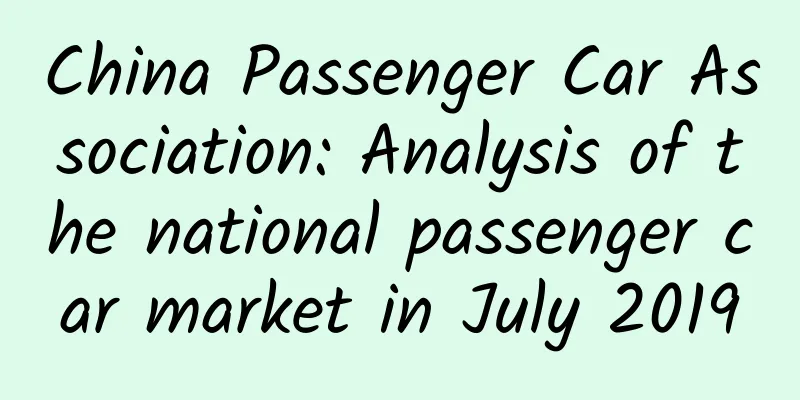|
1. Review of the national passenger car market in July In July, the national passenger car market retailed 1.485 million units, down 5.0% year-on-year and 15.9% month-on-month. From January to July this year, the retail sales of narrow passenger cars fell by 8.8%, and the year-on-year growth rate in July was better than the cumulative growth rate of the year. Since the inventory clearance time before the implementation of National VI was short and the pressure to clear National V was relatively high, retail sales in June were abnormally high, which brought a large overdraft effect on retail sales in July. According to the weekly retail data of the China Passenger Car Association, the number of retail carryovers in early July was relatively large, maintaining a relatively stable weekly growth in the auto market. The July retail data performed better than the actual situation, which is the result of the superposition of multiple factors. First, due to the surge in retail sales caused by dealers' inventory clearance in June, some data was transferred to July to achieve the stable completion of store retail indicators; second, the sales of inventory vehicles in some regions were postponed; and some dealers carried forward some data to July in order to achieve the first half of the year's goals before the deadline to get vague rewards from car companies and improve profitability. At the same time, some wait-and-see consumers waited until the implementation of the National VI in early July to buy cars, which resulted in a good retail performance in early July. The actual growth rate of the auto market retail sales in July was still significantly negative. This was mainly due to the fact that the normal retail prices of National VI models were significantly higher than the clearance prices of National V models during the clearance period, and the overdraft factor of a large number of potential customers converted from the National V promotion had a greater impact on the retail sales in July. The overall retail trend from June to July showed that the year-on-year growth rate gradually stabilized under a low base. In July, the SUV market retail sales increased by 0.8% year-on-year, but sedan sales still fell by 7.2%. In July, luxury brands grew by 24% year-on-year, mainstream joint venture brands fell by 4% year-on-year, and domestic brands fell by 14% year-on-year. In July, the retail sales of vehicle series diverged, and some models switched to National VI models early. The terminal prices were relatively stable, the inventory was well guaranteed, and the market retail sales performance was also strong month-on-month. In July, 1.504 million units were produced, down 10.9% year-on-year from July 2018 and 3.8% month-on-month from June. The manufacturer's inventory decreased by 26,000 units compared with June. Although the full production of National VI models of some enterprises has not yet been completed, the year-on-year decline in production in recent months has gradually improved. In July, the wholesale sales volume of manufacturers was 1.527 million units, down 2.6% year-on-year and 9.5% month-on-month. The channel inventory in July decreased by 5,000 units, mainly due to the decrease in channel inventory caused by the high retail sales. From January to July 2019, the wholesale sales of new energy passenger vehicles reached 645,000 units, a year-on-year growth rate of 53.7%. Due to the sharp increase in sales costs caused by the subsidy reduction at the end of June, it is difficult for all links of production and sales to respond quickly to such cost changes. In July, the wholesale sales of new energy passenger vehicles reached 68,800 units, a year-on-year decrease of 4.2% and a month-on-month decrease of 48% from June. In July, the wholesale growth rate of pure electric passenger vehicles increased by 9% year-on-year and decreased by 54% month-on-month. In July, the sales of plug-in hybrid models decreased by 27% year-on-year and 16% month-on-month. 2. Outlook for the national passenger car market in August There are 22 working days in August this year, which is the month with the longest production time in the whole year. Although some car companies take holidays in August, with the gradual arrival of the announcement catalog and supply support of National VI models, there is great potential for production and sales to recover in August. The current complex and ever-changing external environment has a significant impact on consumer confidence. Some consumers have weak consumer confidence, and first-time purchase demand is far less than replacement demand. The property market has brought residents greater debt pressure, which has a significant impact on the purchasing power of the auto market, and is not conducive to the recovery of growth of domestic brands. In July, manufacturers and dealers took a rest and recuperation mentality, focusing on recycling promotions and stabilizing prices in order to maintain their brand image. The arrival of the new model launch in August will be a powerful factor in driving the gradual recovery of the auto market. As older new energy vehicles are cleared out of the market, the performance of new electric vehicles has generally been enhanced, and it is expected that they will gradually grow after a short-term decline. 3. The auto market is at a crossroads The domestic auto market faces a large impact of the external environment, and the increase and decrease factors caused by environmental and policy factors may be large. The development of the Sino-US trade war was relatively unexpected. In the early stage, it was believed that it would be resolved relatively smoothly. However, the United States announced that it would impose a 10% tariff on US$300 billion worth of products imported from China from September 1. This has a certain impact on the stable development of the export market. It may also cause some migrant workers in the main export areas to return to the central, western and northeastern regions. The auto market has been gradually sluggish since 2017, and the cumulative decline has reached a large level. The main reason is that the demand in the central, western and northern regions is not strong. However, the growth of the East China and South China markets in the past two years is relatively good. In the future, the employment structure of the population may undergo a certain degree of rebalancing, which may bring certain recovery opportunities to the auto market in the central and western regions. The Central Economic Conference also proposed to pay attention to the employment of migrant workers, so the growth of the auto market is also an important means to promote the balanced growth of domestic consumption. 4. The second half of the year economic work conference suppressed the property market and was beneficial to the auto market The Political Bureau of the CPC Central Committee held a meeting on July 30 to deploy economic work in the second half of the year, which is structurally beneficial to the development of the auto market. The meeting clearly pointed out that my country's economic development is currently facing new risks and challenges, and the downward pressure on the domestic economy is increasing. We should tap the potential of domestic demand, expand terminal consumer demand, effectively activate the rural market, and use more reform methods to expand consumption. The consumption demand for food, clothing, housing and transportation is increasing step by step, and the demand for travel is the only mainstream demand that is not being met at present. It is a good thing that the real estate stimulus is not listed as a short-term measure this time. The problem of excessive debt of residents in some regions has suppressed the development of the auto market. Future policies will curb the real estate bubble and prevent local governments from using real estate speculation to achieve short-term money-making tools such as selling land and charging fees. This will help protect people's expectations for buying houses, and the reduction of debt pressure will help the gradual recovery of the auto market. 5. Support for the use of new energy vehicles should be increased The international oil price rose from US$30 at the beginning of 2016 to around US$75 in August 2018, and then went down all the way. Recently, due to various factors, the international oil price has fallen back to around US$54, a drop of nearly US$20 compared with the international oil price in the same period. This is a good thing for consumers to reduce travel costs, but it also has a certain impact on the cost-effectiveness of new energy vehicles. The recent downturn in new energy vehicles in the United States and the weak demand for new energy vehicles in China are related to the reduced cost-effectiveness of electric vehicles. In July 2019, the sales of new energy vehicles in the United States were 26,400 units, a year-on-year decrease of 11%. In the early 2019, the new energy market in the United States weakened significantly, and the characteristics of structural differentiation were more obvious. The growth rate after excluding the star model MODEL3 was very poor, especially the market growth rate of plug-in hybrid vehicles in the United States fell by 28%. The overall growth of new energy vehicles in China is still much stronger than other new energy models in the United States. However, new energy passenger vehicles also declined in July. 2019 is the real decline period of new energy vehicle subsidy policy, especially in July, when the new energy vehicle subsidies were fully reduced. After the withdrawal of local subsidies, there was no supporting policy for the use link. The market-oriented transformation of new energy vehicles may face a hard landing. From the perspective of industry benefits, except for the sharp decline in the automobile industry, the 13 sub-industries of the machinery industry achieved a year-on-year growth of 6.06% in operating income in the first half of the year, which was higher than the growth rate of relevant national industrial indicators. With a sharp drop in profits of 25%, the social responsibility of car companies to develop new energy vehicles at a loss deserves praise. As consumers' demand for fuel-saving new energy vehicles declines, high-fuel-consumption pickup trucks and other models are strong in the international market. Private demand for new energy vehicles in the Chinese market is also in a temporary decline. At this time, it is necessary to effectively improve the comprehensive cost advantage of new energy vehicles. Local governments should increase subsidies for the use of new energy vehicles after the subsidies are cancelled. 6. Beijing’s taxi electrification subsidies are a good guide In order to accelerate the promotion and application of pure electric vehicles in the city's taxi industry and promote the structural adjustment of taxis, Beijing has implemented a financial incentive policy for updating taxis to pure electric vehicles. This is a good policy guidance for the green development of new energy in the public sector. The electrification of taxis has achieved outstanding environmental protection effects. In particular, the effect of reducing exhaust emissions and waste heat emissions is also very good. Taxis travel more than 300 kilometers a day, and the amount of fuel used is huge. The exhaust pollution after becoming pure electric is still very good for the city's environmental protection. The electrification of taxis is conducive to the full layout of urban charging facilities. Taxis have a strong demand for charging. The popularization of electric taxis will greatly increase the demand for charging, which is conducive to a better layout of the charging network. The electrification of taxis in large cities is conducive to the development of intelligent transportation. An inevitable result is to enhance the level of networking and intelligence, which is conducive to the improvement of urban transportation. In the future, with the accelerated advancement of electrification in the rental sector, consumers' acceptance of electric vehicles will continue to increase, and new energy will gradually enter the private or family field, and the progress of the electric vehicle market will therefore be accelerated. |










